- Main pages of this site
- Contents of this page
Introduction
I remember my disappointment the first time I saw Denver Sluice back in the 1990s. It was so small and insignificent-looking I didn't think it was the great Denver Sluice I'd heard so much about, and drove on to another nearby sluice, which is much more impressive, so much so that it has to have two names, the Head Sluice and the AG Wright Sluice. But even that sluice is not exactly "wow!". I was directed back to Denver Sluice, parked and walked over it and back again. It didn't take long. There had to be a mistake. I was looking for the world famous sluice that held back the sea from drowning most of Cambridgeshire and Suffolk; a sluice so great that Dorothy L. Sayers based dramatic events around it in her famous 1930s novel, the The Nine Tailors.Subsequently, I learned that its owners, the government super-power, the Environment Agency, considered it to be of such vital importance that they allowed it to seize up. When criticised by motorists for flooding roads, by anglers for killing fish, by conservationists for drowning birds and by boaters for preventing navigation, they, the almighty EA, spent millions of pounds of our money on consultants who said "unseize it, make it work again; and if you pay us, the fat-cat consultants, more millions, we'll tell you how." Well, that was the talk in the pubs, on the river banks, in the boatyards and bird hides. Was I missing something? Shouldn't they, the all-knowing EA, have known to do that, and how to do that, and spent the money doing that?
In fact, I've discovered that now, in 2012, after dozens of expensive consultants reports, and enough money paid to civil enginneers to cover the Welney Wash Road several feet deep, it mostly does work, at least when circumstances permit. And when that is the case, Denver Sluice controls the flow from the non-tidal branch of the Great Ouse River known as the Ely Ouse, or Ten Mile River, into the tidal reach of the Great Ouse River known locally as the Tidal River, at a point just above where the New Bedford or Hundred Foot River joins the Tidal River. It should be noted that Denver Sluice also prevents the tide going up the Ely Ouse, overflowing its banks and flooding the low lying land much of which is below sea level. I've also discovered that there are many occasions when circumstances do not permit. Rain, tides and silt, for instance. Especially the latter.
Another thing I've learned is that one small sluice doesn't have much street cred in the drainage world. So, over the years, four more have sprung up nearby directing water hither and thither, and to emphasise how difficult it all is it to manage, they've named the whole site "Denver Complex". None of the five sluices are geographically within the Ouse Washes, but they are major players in the operation and management of the Washes, and all the main structures of the Washes are controlled by EA staff based at the Complex.
The navigation lock and a short section of the Tidal River allows passage for pleasure craft between the Nene and Ouse river systems.
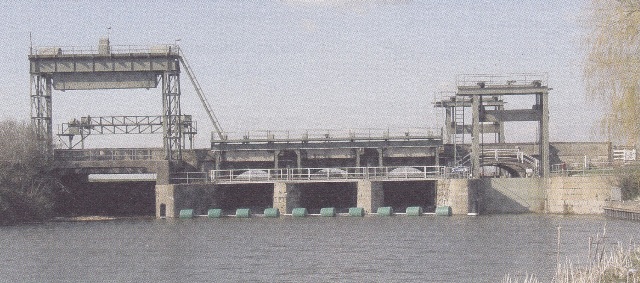
The sluice and lock(s) c2006, seen looking north from the Ely Ouse/Ten Mile River.
Left to right: The "Big Eye" (a sealed-off sluice/navigation gate for large commercial vessels); the "little eyes" (the three sluices); and the navigation lock. (Photo: EA)
|
page last updated 22 April 2018 |
| If visted before, please "refresh" page to see latest version. |

chronology summarised by
Prof HC Darby's in his book
| event | year per EA sign |
year per Prof Darby |
engineer/designer, features |
| Built | 1651 | 1652 | by Sir Cornelius Vermuyden |
| Improved | not mentioned | 1682 | |
| Blew up | not mentioned | 1713 | |
| rebuilt | 1730 | 1750 | by C Labelye Navigation lock added, 11m x 4m |
| reconstructed | 1834 | 1832 | by John Rennie New lock, 23m x 5.5m, with 4 sets of mitre gates, 2 pointing upstream, 2 downstream, allowing navigation regardless which side had highest level. |
| enlarged | not mentioned | 1923 | new navigation gate added, named "Big Eye" |
| lock changes | not mentioned | post Prof Darby's book | small navigation lock Vee doors replaced with 2 x VLGs, increasing length by 7m [to 18m?] |
Prof Darby's date for the rebuilding by Labelye in 1750 is suported by others, including Wells and Summers, and can be taken as correct.
back to contents
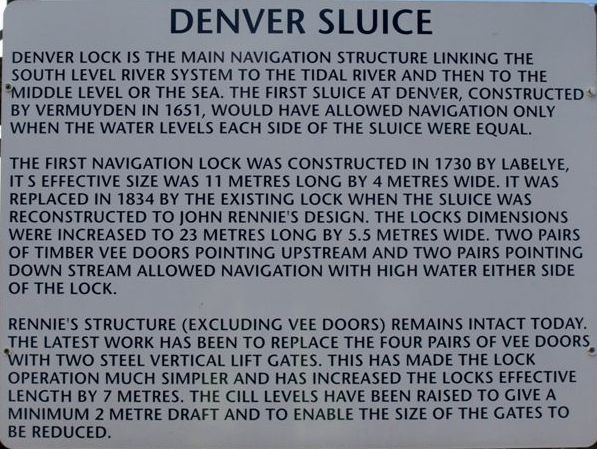
Information sign
displayed at Denver Sluice
Vermuyden's 1651 Dam and Sluice
Vermuyden built Denver Sluice for the Company of Adventurers in 1652-3 immediately following, or as part of, his second phase of works in this area - the creation of what is now called the Ouse Washes. It was almost universally condemned, making navigation difficult and at times impossible, and allowing the river downstream to silt up through lack of scouring.According to Samuel Wells (1830, Vol 1, pps 739-740) Vermuyden built it "in order to force the tidal waters in a straight course up the Hundred Foot river, instead of allowing them to flow in their natural and more circuitous channel up the Ten Mile, or Ouze River."
Wells continued "The centre of the sluice appears originally to have been formed with a dam of earth strongly piled, having on one side two small brick sluices, for the purposes of navigation."
back to contents
1682 improvements
Wells says "In the year 1682, various alterations were effected in the formation of the sluice : three brick arches were set down where the clow or dam stood: the middle arch was made 18 feet, and the two others 12 feet wide : doors were formed in each arch, capable of being taken off or set open to let in tides ; and it was conceived, that these expedients would allow a much better water-way than formerly ; and that a greater facility would be afforded to navigation, than existed before the erection of the original dam or sluice."back to contents
1713 - Sluice collapsed
One source I found somewhere said that in 1713, violent tides rushing up the river met floodwaters coming down undermining and "blowing-up" the sluices and dam. However, it seems the solid dam or wall, eight feet higher than the original river bed, remained.Prof HC Darby notes in his book, The Changing Fenland, that the Bedford Level Corporation (BLC) recorded in their minutes at the end of March 1713 that the sluice was "in tollerable repair" yet when some BLC members met at Denver in July they found it close to collapse because two of the upstream piers had been undermined. Apparently July had been very wet resulting in considerable floodwater coming down stream.
Darby also refers to Thomas Badeslade writing in 1725 that after the undermining from upstream, the sluice was "blown up" by incoming tides. Badesdale also stated that without the sluice, the New Bedford/ Hundred Foot River then turned towards Ely instead of flowing to Kings Lynn, which Badesdale says could have been prevented if the Hermitage Lock at Earith had been opened as soon as Denver Sluice collapsed to allow the Ouse to flow along its old course to Denver.
Labelye's 1750 Sluice and Navigation Lock
This was a great improvement, with wider waterways, lower foundations, and a proper navigation lock on one side.back to contents
Rennie's 1834 Sluice and lock
Seen in 1923 from upstream just prior to the 1924-5 works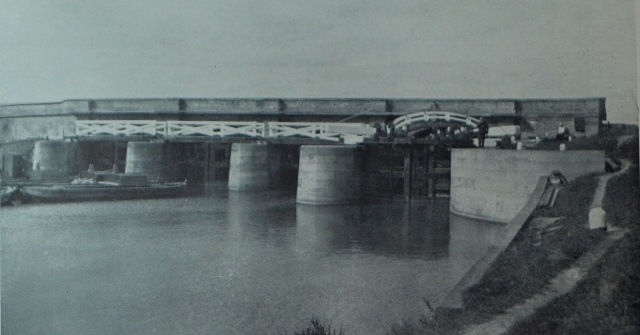
(photo: Camb. Antiq. Soc., shown as plate 9 in HC Darby's book)
Note: the little eyes have mitre gates upstream as well as downstream and both sets open away from the sluice; the white painted timber walkways over the litle eyes of an 18th century pattern seen throughout the area ; an arched timber walkway over the navigation lock; the brick parapet of the road across the sluice; and the lighters on left - are they steam driven?
The lock arrangement allowed for the fact that unlike canal locks (which always have water levels lower on only one side and the lock gates pointing downstream) this lock may have lower water either side, so it had four sets of mitre gates allowing operation regardless of levels.
back to contents
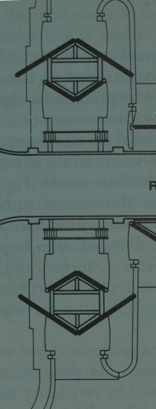
plan of Rennie's lock
showing 4 sets of mitre Vee doors
1923-25 enlargement and improvements
The sluice seen below from upstream in 1924-25 after various works, including the addition of the "Big Eye" (on the left) with a single lift gate 35ft wide. This was said by Oscar Borer, Chief Engineer of the RGOCB, to replace two smaller sluices (The Cambridge Region, 1938, p200), suggesting there were 5 openings previously. Other sources say it was for navigation by commercial craft wider and/or higher than the lock on the right could take. Another change was replacement of the upstream mitre gates of the little eyes with lift gates. There is now a metal walkway above the wooden one for access to the lifting gear .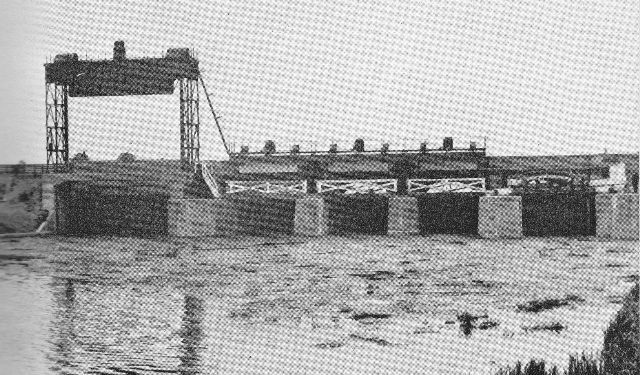
(Photo: from Summers "The Great Ouse", p33)
The plan on right shows the big eye with two lift gates, as does the 1938 photo below seen from upstream, making it a proper lock with navigation possible regardless of tide, but as the gates are only 50 ft apart, only for short vessels. Is the downstream lift gate raised? The arched walkway over the small lock has changed, now appears to be metal.
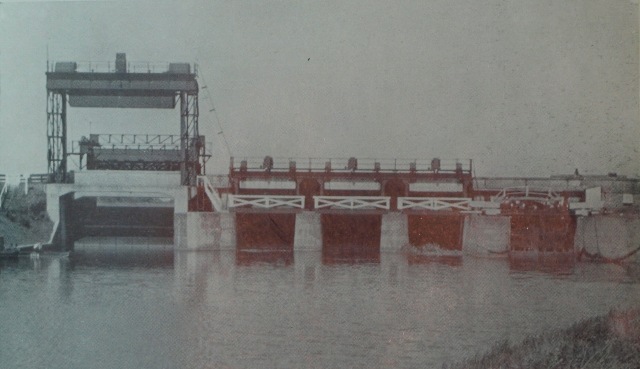
(Photo: HC Darby, The Changing Fenland, fig.52)
back to contents
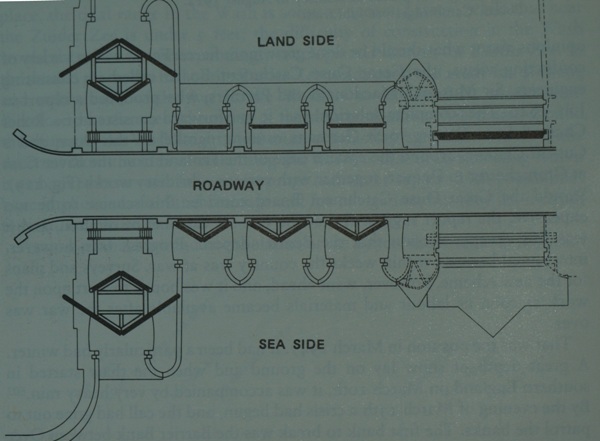
plan of sluices & locks in 1924
shown in Prof HC Darby's book
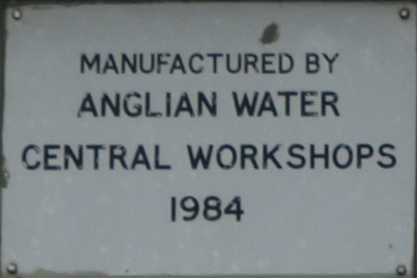
plates on the lock guilotine gates
1982-86 Re-furbishment
This is referred to as an "event" in figure 4-1 on page 25 of the September 2009 EA document "Great Ouse Tidal River Strategy Review, SEA Environmental Report", but no details are given. However, we do know the vee-doors/gates of the lock were replaced with guilotine vertical lift gates because one of the EA's predecessors thoughtfully and proudly affixed plates to them. So far to I have found no earlier reference to changes to Rennies 1834 gates - surely they couldn't have lasted 150 years?back to contents
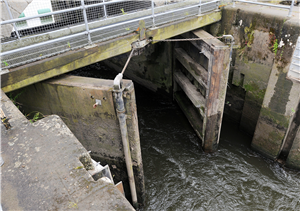 The "restored" little eye opened
The "restored" little eye opened(Photo: Matthew Usher, EDP 24,
July 2008)
2008 Little Eye inspection & repairs, and de-silting
In 2006, nearly 15 feet of silt was against the downstream "V" doors of the little eyes, preventing them from opening, The EA say it was because of sluggish river flows [from upstream] in the dry winters of 2004-5 and 2005-6. Others claim it was because the Ely Ouse had been allowed to discharge through the relief channel rather than through the sluices and the EA had not bothered to clear the silt, which builds up anyway because of the nature of the Tidal River.Temporary barrier gates known as stop-logs or damboards were placed in front of the eyes, and the gates checked. Below, one eye is now working (although closed), the other two are still closed off.
(Photo: EE, July 2008)
The EA said various air and water jetting systems were being considered to keep the doors clear of silt in future, and trials may begin next year.
In fact, pipework for air blasting the silt was in place in Dec 2008, see right.
back to contents
 De-silting pipework above little eyes
De-silting pipework above little eyes(Photo: EE, Dec 2008)
current arrangement
The current view from upstream, with the navigation lock's 2 lift gates. The timber walkway seen in the earlier photos has been replaced by metal, and the Big Eye has lost its downstream gate, replaced by a concrete slab.
(photo: EA, c2006)
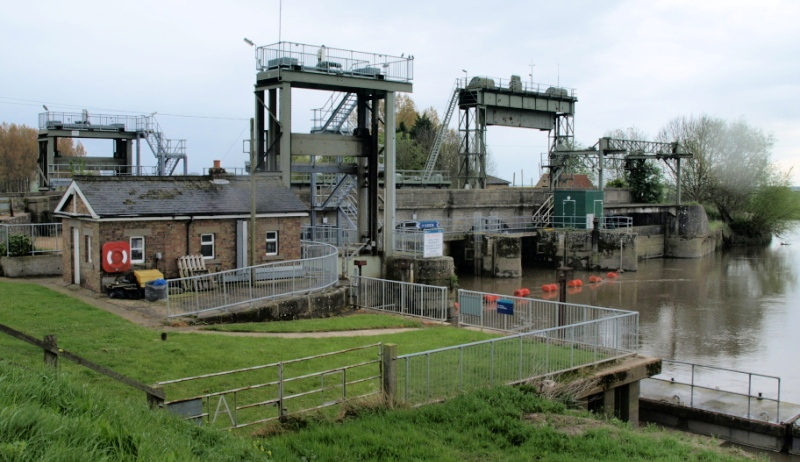
(photo: Eddy Edwards, 2012)
Left to right, upstream guillotine lock gate, lock keepers office, downstream guillotine lock gate, three little-eyes (one hidden), the unused big-eye upstream guillotine gate with counterweight raised, the green cabin on the far little eye controlling the the de-siltting/jetting equipment on the little eye vee doors, the downstream big-eye downstream structure with gate & counterweight removed and blocked off with a concrete slab, and the Hundred Foot river joining the Ouse "tidal river".
back to contents
Operating rules
Rules were set out in the draft Ouse Washes Water Level Management Plan of 2002. I have not been able to get the EA to tell me whether that plan has been adopted, or superceeded - I can't believe it hasn't - so details below may be incorrect, and no doubt are subject to lots of ifs and buts, including the effects of drought and siltation.The rules set target figures for river levels at various places. Denver Sluice has three sluice outlets and any combination of the three can be used to achieve the targets. The outlets are known as "little eyes"; each has a vertical lift gate at the upstream (u/s) south end and a set of mitre gates at the downstream (d/s) north end pointing into the Tidal River.
Operation is by raising the upstream lift gate when tidal conditions downstream will allow the mitre gates to open under gravity, ie upstream pressure, when the tide is low enough - and if silt isn't blocking the mitre gates!
The sluices are monitored and adjusted by resident sluicekeepers.
If necessary, the slackers on the navigation lock can be opened to increase discharge.
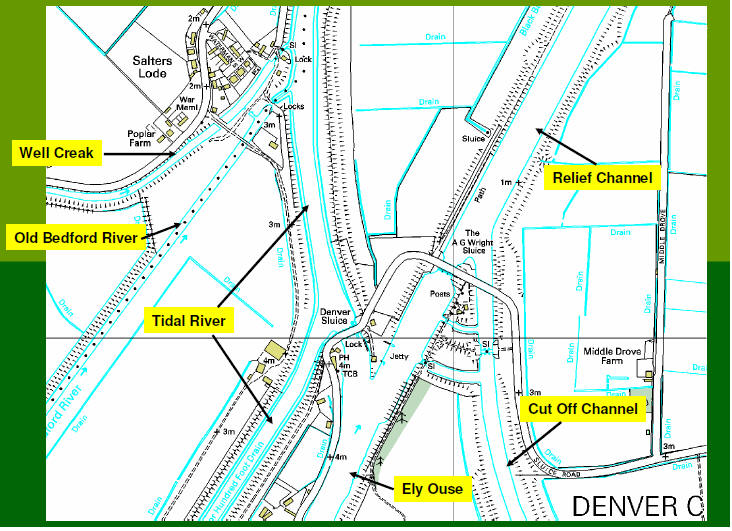
Plan of Denver Complex.
(Source: EA)
All figures are AOD.
"Winter" 1st November to 31st March.
- Denver Sluice to be used for all discharges.
- Try to maintain Ely Ouse levels of 1.5m at Ely and 1.22 to 2.13m immediately u/s.
- Cut-Off and Relief channels should not normally be used.
- Anticipate floods. Use Denver to reduce levels in South Level in advance to maximise storage
- Cut-Off Channel to be held at -1.0m (using Impounding Sluice) and Relief Channel at -1.0m.
- Cut-Off and Relief Channels may be used in conjunction with Denver Sluice if the above level limits cannot be maintained
- Close Denver during flood peaks and maximise Welmore Lake Sluice discharge to minimise flooding of Welney causeway.
"Summer" 1st Apr - 31st Oct
Washes NOT flooded (Welmore Lake u/s level less than 0.9m AOD)
- Denver Sluice is to be used for all discharges.
- Try to maintain Ely Ouse levels of 1.6m at Ely and 1.37m to 1.7m immediately u/s.
- Cut-Off channel to be held at -0.2m using Impounding Sluice
- Cut-Off and Relief Channels may be used to relieve local flooding from
Wissey, Little Ouse and Lark rivers, PROVIDING level in Cut-Off Channel is not
allowed to exceed
-0.2m at the Impounding Sluice for more than 24hrs in a 72hr period. - Flow through Residual Flow Sluice must not exceed 6m3/secs
Washes FLOODED (Welmore Lake u/s level exceeds 0.9m AOD)
OR Offord discharge exceeds 30 cumecs.
- Denver Sluice should be closed, provided soil moisture deficit greater than 50mm.
My comment
So, there you have it. The draft 2002 WLMP has over 60 pages, and just once "Offord" is mentioned, a single word in a sub-title of the Denver operating rules as shown above. It is not explained, nor is it in any other EA publication I've found. Yet what happens there can determine whether Denver Sluice should be open or closed. My assumption is that even if the Washes are not flooded, they will be soon if the river flow at Offord (near St.Neots) is above the figure stated.Just as strange is the mention of "soil moisture deficit". I wonder what that is, and where it is tested?
back to contents
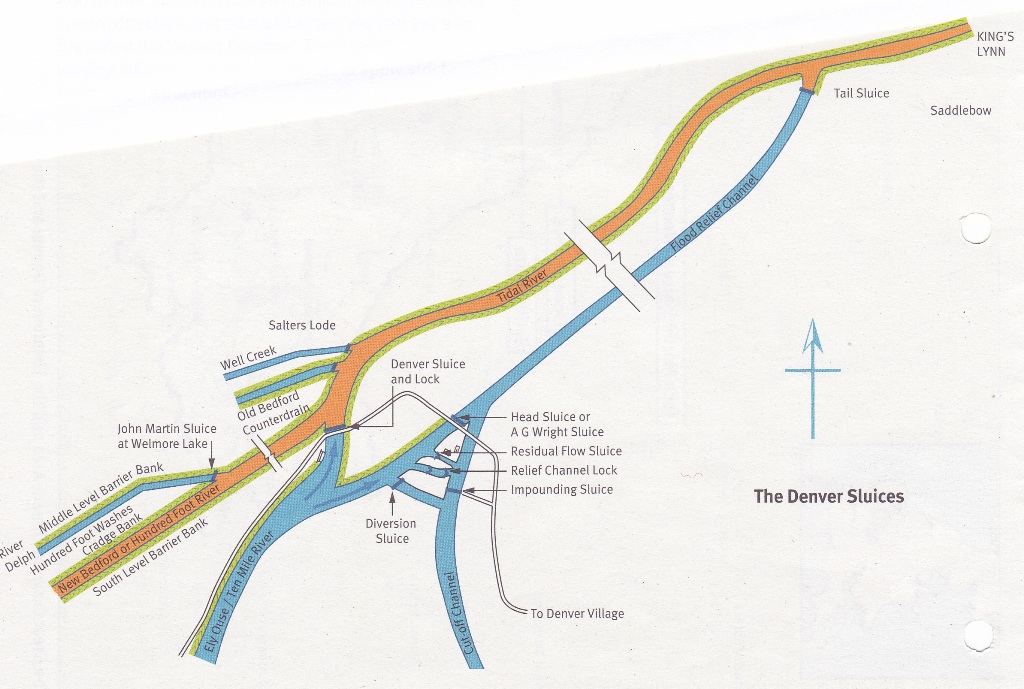
Plan of Denver Complex.
(Source: EA)
Great Ouse Flood Protection Scheme 1953-1964
Vermuyden was concerned about flooding in the South Level and suggested remedies in his famous 1642 "Discourse". One was to drain the Ely Ouse into the Tidal River more quickly than Denver Sluice and the upper part of the Tidal River could manage. This he dealt with it in the 1650s by cutting a new channel named Downham Eau or St. John's Eau, from Denver, but by-passing the sluice, running along side the Tidal River to Stow Bridge. I assume it joined the Tidal River there, but have never found evidence in books or maps of how it did so.His other idea was to join the main South Level rivers which he refered to as "Mildenhall", "Brandon" and "Stoke" (i.e. Lark. Little Ouse and Wissey) to a new cut to skirt the fens and join the Great Ouse at Denver rather than flowing individually into the Ely Ouse.
TThree hundred years later, those two ideas were the basis of a £10 million scheme to relieve flooding in the South Level. Two new channels, the "Flood Relief Channel" and the "Cut Off Channel" were dug to carry and store excess flows which those four rivers could not hold or Denver Sluice handle. Work began in 1953-4 and was completed after 10 years.
(Flood) Relief Channel
This was cut during 1960-61. It starts from a cut off the Ely Ouse immediately south of Denver Sluice running in Vermuyden's 1650s drain along side the Tidal River to Stow Bridge then in a new cut to Kings Lynn. Flows are controlled by the AG Wright Sluice, known as the Head Sluice, on the northern edge of Denver Complex, and the Tail Sluice where the channel joins the Tidal River at Saddlebow, Kings Lynn. The Ely Ouse can therefore be discharged into the Tidal River via Denver Sluice or diverted into the Relief Channel and held until tides allow discharge via the Tail Sluice.The AG Wright Sluice is of reinforced concrete and has three openings, each with a vertical lift gate (VLG) 30ft wide. The Tail Sluice has seven openings, each with an u/s VLG and a d/s steel flap gate 30ft wide x 22 ft high.
Cut Off Channel
This was started in 1953, and runs 27½ miles from a head sluice (constructed 1960?) on the R Lark at Barton Mills to the Relief Channel immediately north of the AG Wright Sluice, originally unimpeded but later via the Impounding Sluice at Denver Complex.It runs under the Little Ouse at Hockwold-cum-Wilton, and under the Wissey south of Stoke Ferry, and can take excess water from both via sluices, all much as Vermuyden suggested.
other sluices at Denver
There are two other, the Diversion Sluice, and the Residual Flow Sluice.I saw both during an open day in 2008; I didn't understand what they did then, and still don't.
There is also a relief channel lock enabling navigation from the Ely Ouse into the Relief Channel. This is not as I read somewhere a lock added to the AG Wright Sluice, but built into a cut between the relief channel u/s of the AG Wright lock, into the Cut Off Channel d/s of the Impounding Sluice, thereby by passing the AG Wright Sluice.
|
Acknowledgements. Text and photos except where noted © Eddy Edwards, 2010-12 If you think there are any errors or omissions on this page or would like to comment, please e-mail me and your response will be noted where appropriate. |
back to contents
| Related pages on this website |
| Denver Sluice open-day 2008 |
| Related external websites/pages |